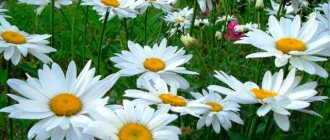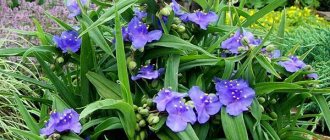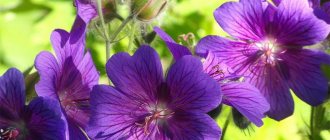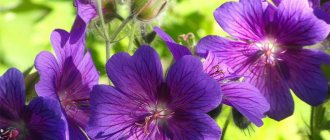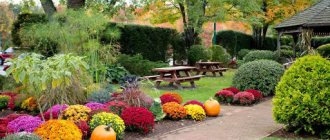Author: Elena N. https://floristics.info/ru/index.php?option=com_contact&view=contact&id=19 Category: Garden plants Published: February 26, 2018Last edits: November 04, 2020
- Rules of care
- Swamp cornflower (Leucanthemum paludosum)
Leucanthemum (Latin: Leucanthemum) is a genus of herbaceous perennials and annuals of the Compositae, or Asteraceae, family, which was previously classified in the Chrysanthemum genus. However, unlike chrysanthemums, nivyaniki do not have a characteristic aroma and are not covered with grayish hair. According to various sources, the genus Nivyanik includes from twenty to seventy species. The scientific name “leucanthemum” is translated from Greek as “white flower”, and the Russian “nivyanik” is a derivative of the word “niva”. Most species of cornflower come from Europe and temperate regions of Asia, although cornflowers are also found in North America, New Zealand and Australia. In culture, cornflower is more often called garden chamomile and is widely used in landscape design and landscaping. In this article we will tell you what the cornflower looks like, how it reproduces, when to plant cornflower seedlings, and when to sow it in open ground and how to care for it in the garden.
Description and features of the cornflower
The flower does not have grayish pubescence, like chrysanthemums. Deprived of their characteristic odor. Distinctive features of the cornflower:
- height up to 0.6 m;
- superficial rhizome;
- straight trunk with edges;
- basal and stem leaves on elongated petioles;
- bladed or serrated plates;
- inflorescences in the form of a hemisphere, united into corymbs;
- lemon tubular buds are collected in baskets in the center;
- flowers are developed, falsely ligulate, snow-white along the edge.
Nivyanik blooms 2 times a year: in May and August. In September, with the onset of frost, the buds wither.
Cornflower is a herbaceous plant. All its varieties have one-sided seed pods. In large-flowered specimens they ripen with sufficient sun. In shade or partial shade, the seed does not begin to form, and the shoots become deformed.
Small-flowered varieties are less susceptible to lack of bright light. For intensive growth, loose, neutral or alkaline soil is required: sandy loam or loam.
Differences between cornflower and wild chamomile:
- large buds;
- solid plates in many varieties;
- long, straight trunk without branches;
- There is only one flower on 1 shoot.
Despite the fact that cornflower is popularly called garden chamomile, the plants are only distant relatives.
Growing cornflower: feeding, lighting
How to grow a large garden chamomile on a plot?
The flower needs attention. Nivyaniki love good nutritious soil, an open sunny place, frequent division, fertilizing twice a season.
Moreover, in the spring they can be watered with an organic solution, and after flowering - with mineral fertilizers, also preferably in liquid form.
Nivores have many enemies - they are easily affected by fungal diseases, so do not get carried away with nitrogen fertilizing, carry out preventive treatments with biological fungicides (Alirin, Gamair, Fitosporin) in the spring and chemical ones when diseases appear.
Aphids can also damage flowers; use systemic insecticides Confidor, as well as its analogues.
When growing nevus for cutting, the bushes must be divided annually, soil well fertilized with organic matter must be prepared and watered regularly.
Flowers reproduce vegetatively; during seed propagation, the characteristics of the variety are not preserved. The exception is the Crazy Daisy variety.
It is better to divide nivberry bushes in the spring: in the fall many plants die. Cuttings are taken in the second half of summer, while small basal rosettes are planted.
Designers classify nivyaniki as permanently ornamental plants. They can be used in mixborders, borders, and are good in group plantings. These magnificent perennials are excellent partners for many flowers: bluebells, cornflowers, paniculate phlox, and especially spotted ones if the “daisies” are tall.
Nivyaniki make excellent cutting plants. Bouquets of the simplest snow-white varieties with inflorescences of astilbe, gypsophila or basilisk look great. They stand in water for a long time, especially when adding the drug HB-101 (according to the instructions).
Cut cornflowers
The flowers stand well as cut flowers. However, if you need to preserve flowers for a long time, they are wrapped in paper and placed in the vegetable compartment of the refrigerator (+2...+4 degrees)
At the same time, vegetables and fruits must be removed from there, otherwise the flowers will quickly wither. This way they can be stored for about 2 weeks without losing their appearance.
It is important that they do not receive light, so the paper is used in several layers
After the niveries have been taken out to make a bouquet, the stem sections need to be renewed. Then wrap it in a paper cone, staple its edges on top and place them in water again until they restore turgor. After about an hour, the paper is removed.
Nivyanka cuttings
Nivyaniki are easy to propagate by dividing the bush in spring or autumn, and the Largest one is better in spring or at the very beginning of autumn.
The rhizome usually grows quickly; in a couple of years, a small piece will already form a small clearing. Of course, many new varieties are not so fast. The delenks need to be provided with at least minimal space - an interval of 30 - 40 cm.
You can take cuttings of cornflower in the first half of the season, first by cutting off the young green shoots, and later by cutting off the coarsened (semi-lignified) ones, which are divided into parts up to 15 cm in size.
Usually only new varieties and cultivars are grown from seeds, sown in pots or beds before winter or spring. Many cornflowers (excluding rare species) set seeds well, they have time to ripen, and are actively sown.
Types of cornflower
Only some varieties of the plant are cultivated:
| View | Description | Leaves/Flowers | Varieties | Features of their flowers, period of bud formation |
| Ordinary | Perennial up to 1 m in height. Drought-resistant, shade-tolerant. | Glossy, with teeth along the perimeter. Simple, with a tubular, yellowish core, snow-white petals in the form of tongues. | Maxima Koenig. | Diameter 8-12 cm. May-July. |
| May Queen. | Semi-double. Late spring-early August. | |||
| San Souci. | Large, terry, lemony in the center. Second decade of summer. | |||
| Largest | Grows up to 1 m. A distinctive feature is late flowering. | Basal, dark green, crenate. Large, simple, terry. | Alaska. | 10 cm. From early July to late autumn. |
| Snow Lady. | With a lush center, wide petals. From the 2nd month of summer until the first frost. | |||
| Little Princess. | Simple. From late June to October. | |||
| Crazy-Daisy. | Looks like a chrysanthemum. July-end of September. | |||
| Broadway Lights. | Simple, soft amber. From the 2nd decade of summer to mid-autumn. | |||
| Mayfield. | They grow in 2 rows, snow-white, reed-shaped. July-September. | |||
| Silver Princess. | Simple. From the end of June to October. | |||
| Wirral Supreme. | Semi-double. From early July until frost. | |||
| Snow White. | Densely double, collected in baskets. From mid-summer until the end of the season. | |||
| Fabulous | With strong stems, up to 1 m in height. | At the base they are collected into sockets. Long, up to 30 cm. Terry, from yellowish-green to creamy-pink in color. | Fiona Goghill. | Petals are light beige. The core is lush, canary-colored. June July. |
| Spring giant. | Large, simple, snow-white. Mid-summer-October. | |||
| Grand Illusion. | Collected in baskets. June July. |
Where does common popovnik grow?
The species is widespread in Europe, temperate zones of Asia, is found in North America, and has taken root well in Australia and New Zealand. It grows in the European part of Russia, in Siberia and Crimea, as well as in the Caucasus.
Common popovnik, the description of which is given in the article, prefers open sunny meadows, wide forest clearings and woodlands, gentle slopes and fields. The flower reaches for the sun and does not take root in shaded areas.
When to sow garden chamomile in open ground
If you sow from the end of March to the beginning of May, the sprouts will sprout within half a month. By the end of summer, the bushes will get stronger and bloom next season. If you sow cornflower in late autumn, then seedlings can be observed in the spring, buds will begin to form in the summer.
Step by step sowing:
- Place the seeds 2 cm deep into the substrate.
- Between rows 0.2-0.3 m.
- Water, making sure that the liquid does not stagnate.
- After the emergence of seedlings, they carefully break through so that there is 9-15 cm between the seedlings.
- If it is a pity to throw away the torn bushes, they are replanted. Even small sprouts take root well in moist soil mixture.
- The grown seedlings are planted at 0.4-0.5 m.
With proper care, cornflower grows quickly.
Etymology of the name. Synonyms
The Latin name of the flower is Leucanthemum vulgare. Derived from two Greek words:
- leukos - translated into Russian as “white”;
- anthemon - means "flower".
Thus, the scientific name is closely related to the appearance of the flower, which is similar to a white daisy.
Nivyanik is the Russian name for the plant. Derived from the word “niva”, which means a wide treeless space. Considering that nivyanik grows in open areas of land, it can be assumed that the Russian name of the flower characterizes its distribution.
Popularly, this chamomile (nivyanika) is called differently: whitehead, navel, popovnik, white, meadow nivyanka, roman grass, white flower.
How to grow nevus seedlings at home, when to plant
If you do not plant the cornflower immediately in the garden plot, but first grow the seedlings, the appearance of buds can be observed already in the first year. Cultivation begins in late winter-early spring:
- Containers are filled with light, nutritious soil. The seeds are deepened a centimeter, watered, and covered with polyethylene or glass to create a greenhouse effect.
- Seedlings are kept at +22 °C and provided with diffused light. The shelter is removed daily for ventilation and watering.
- After 2-3 weeks, when shoots appear, the glass or polyethylene is removed. The lighting is left the same. The temperature is reduced to +17…+20 °C.
- After the appearance of 3 true leaves, the sprouts are planted in separate pots with a soil mixture of sand, peat, and leaf humus in equal quantities.
- Water and keep in bright light.
- Starting in May, the grown bushes are hardened off: they are taken outside for 2-3 hours. At first, the pots are placed in a shaded place, protected from strong winds and drafts. When the shoots get used to it, they are left in the sun. Thanks to hardening, the cornflower gets sick less often.
They are transplanted into open ground at the end of spring if the ground does not freeze at night.
Perennial in the garden
This beautiful flower will look great anywhere in the garden. It is good both for independent planting and in a prefabricated flower bed. Leucanthemum will perfectly shade other plants and add freshness to the landscape.
Low-growing flower species thrive in rockeries, slides and mixborders. They will make a picturesque border.
Many people plant nevberry for cutting. From tall plants you can make a wonderful bouquet that will retain its quality for 10 days.
When creating compositions from nevberry, you should take into account the need for its renewal and pruning. Therefore, it is better to plant it so that you can approach it without causing damage to other plants.
Anyone who wants to make their garden unique should definitely plant this plant. It will add a touch of charm and won't require much in return.
Caring for garden chamomile in the open ground
For the first 2-3 years the bushes will be small in size.
When creating comfortable conditions and proper care, the nevus grows quickly: in just a few months it will reach 80 cm in circumference and 1 m in height.
Choosing a landing site
It needs to be planted in a well-lit place. Minor shading is acceptable. With a lack of light, the shoots will grow upward strongly, and the nivaria will lose its decorative appearance.
Priming
Take light, loose, fertile soil. The bush grows well on chernozem, loam of neutral or weak acidity. At a high pH level, the flower will die; on clay and sandy substrates, flower development will be slow.
How to water
Moisten regularly when the top layer of soil dries out. In this case, you need to ensure that there is no stagnation of liquid. During severe drought, add 10 liters of water to the root. To preserve moisture, mulch the bush with sawdust, wood chips, and spruce branches.
Feeding
Fertilize every 2 weeks. Alternating mineral mixtures with organic matter will be beneficial. If you skip the fertilizer, nothing bad will happen; nevus grows well on garden substrate.
How to prolong flowering
The formation of seeds takes away the plant's strength. If there is no need to collect seed, it is better to cut off the inflorescences immediately after wilting. This also encourages re-blooming.
Preparing for winter
After the petals fall, you need to prepare the cornflower for dormancy. Cut off the stems, leaving 0.1 m with basal leaves.
A distinctive feature of the plant is winter hardiness, but in frosts below -20 ° C you need to cover the bush with pine needles, fallen leaves, and mulch with peat. Remove the shelter in early spring.
Flower propagation
In order for the plant to provide pleasure with its appearance longer, it must be regularly updated. You can do this in 3 ways:
- Dividing the bush. This is the simplest option. It is better to do this in the spring so that the new plant takes root and overwinters without problems. But if everything is done correctly, autumn replanting will not cause much harm either. There is nothing complicated here. You need to dig up the bush without damaging the roots, and carefully divide it into parts. Planting is done in holes, the size of which depends on the size of the roots of the dug plant. At the bottom of the hole you need to put a mixture of earth and humus. After planting, the flower needs to be watered and the soil mulched. The recommended distance between holes is 40−50 cm.
- By cuttings. It can be carried out throughout the summer. You just need to separate the root rosette from the plant and immediately plant it in a permanent place, watering the soil abundantly.
- Planting seeds. With this method, it is better to purchase seeds in a store, since the material collected independently does not guarantee the preservation of the varietal properties of the plant. The only exception is the Crazy Deizy variety. This breeding option is more labor-intensive and time-consuming.
Control of diseases and pests of neviberry
If there are errors in care, the nevus can get sick. Common lesions, their signs, therapeutic and preventive measures:
| Diseases | Manifestation on leaves | Prevention and remedies |
| Mosaic is a viral infection. |
|
|
| Soft bacterial rot (infection occurs through the soil or affected plants). |
|
|
| Ramulariasis. |
|
|
| Septoria |
|
|
| Root rot. |
| Before planting, place in Trichodermin or Alirin-B solution. |
| Pests | ||
| Chrysanthemum leaf miners (larvae of flies and moths). |
|
|
| Thrips. |
|
|
| Pennitsy. |
|
|
| Aphid. |
|
|
How to prepare medicine from popovnik
It’s easy to prepare the drug:
- Infusion for drinking - pour 2 large spoons of dried herbs with flowers with a liter of boiling water, boil for 3-5 minutes over low heat, cool. Then strain through a double layer of gauze. Drink 20 g 3 times a day.
- For douching - pour 2.5 tablespoons into two glasses of boiling water, boil for no more than 5 minutes, cool. Strain very carefully. Use warm overnight.
- For lotions, prepare a strong decoction at the rate of 1 tablespoon (without top) of dry raw materials per half glass of boiling water.
- Alcohol medicinal tincture - take fresh nettle and nettle leaves in equal parts, wash and dry. Grind in a blender or through a meat grinder. Pour the green mass with an equal volume of medical alcohol. Leave for 15 days in a dark place. Strain the finished tincture. Take 20 drops twice a day.
- Ointment - pour 2-2.5 tablespoons of dry herbs and meadow chamomile flowers into a saucepan, squeeze a small tube (50 ml) of baby cream into it. Place in a water bath for 30-40 minutes, while the drug must be constantly stirred with a wooden spatula. After cooling, apply a thin layer to affected areas three times daily. Store the ointment in the refrigerator.
Obtaining your seed material
To grow nevus, you can use seeds collected from your plants. You need to understand that hybrid seeds do not transmit parental qualities. This rule does not apply to varietal varieties that are distinguished by the stability of the transmitted characteristics.
Nielberry seeds have excellent germination and winter hardiness. You can plant them immediately after assembly and wait for flowering next year. The seeds of the common cornflower are especially tenacious. It self-pollinates so effectively that many treat it as a weed and control it with herbicides.
The strongest and most beautifully flowering specimens are selected in advance and, without pruning, are allowed to bloom until the end. Seed material is collected at the end of August or September. A flower ready for collecting seeds has a completely dried stem and a dry capsule; when pressed, it cracks easily.
If you don’t plan to plant the seeds right away, they are dried for 7-14 days on a napkin (or whole with baskets) at room temperature. Then they are placed in paper bags with small holes.
A little about the plant
What is the difference between chamomile and cornflower?
The main differences are that the flower basket itself is larger, it has only one stem with one flower, while chamomile has a branched stem and many flowers. There is also a difference in the shape of the leaves. In chamomile they are separate and feathery, while in nevus they are whole. And finally, cornflower is mostly a perennial plant, while chamomile is an annual plant.
In total there are about 20 species of this plant. Even less is grown by amateurs. The most common:
Common cornflower, also known as meadow chamomile or popovnik. Swamp cornflower. Nivyanik Kurilsky. Nivyanik is the largest.
But there are many varieties obtained from these species. There are early and late, tall and small, with double flowers and simple. The largest number of hybrids was obtained from the largest cornflower. There are not very many varieties of common cornflower, the most unpretentious and widespread, and their main difference lies in the height of the stems. But unlike N. the largest, it blooms earlier. In general, the height of the nivberry stems ranges from 30 centimeters to a meter, and the size of the flowers can reach 15 centimeters in diameter.
When purchasing one or another variety of cornflower, be sure to take into account that not all of them tolerate winter equally well. It is native to Europe and tolerates winter relatively well, but even hardy species may not survive severe frost. Therefore, purchase only the one that is suitable for planting in your area, and even then, it is better to cover it for the winter. It should also be taken into account that there are also annual hybrids.
Nivyanik looks great as a single plant or in a group with other flowers. Low-growing varieties are used as border plants, while tall varieties create an excellent background for a variegated flower garden. It blooms almost all summer. Nielberry is also good for cutting. Most often it is used in composition with other flowers. A bouquet made, for example, of alstroemeria and cornflower, looks magnificent and elegant.
What is terry
Flower doubleness is an anomaly associated with an increase in the number of petals during the process of transformation of other parts of the plant caused by external factors. The terry nature of the nivaria is achieved through the selection of different varieties, the addition or deprivation of certain nutrients, infection with a bacteriological or viral disease that does not affect the viability of the plant.
Sometimes double varieties are sterile, like other hybrids, or, more often, lack the ability to pass on altered genetic material through growing from seed to the next generation. If for some reason the mutations are persistent and transmitted to new plants through seed material, then such a hybrid becomes a variety.
Literature
Wikisource has texts on the topic Chrysanthemum Leucanthemum
- Ch.
editor: Gilyarov M.S.; Editorial team: Baev A.A., Vinberg G.G., Zavarzin G.A. and others. Biological encyclopedic dictionary. 2nd ed., corrected.. - M.: Sov. encyclopedia, 1989. - Plant life. In 6 volumes. T. 5. Part 2. Flowering plants / Ed. A. L. Takhtadzhyan. - M.: Education, 1981. - P. 472.
- Botany. Encyclopedia “All the Plants of the World”: Trans. from English (ed. Grigoriev D. et al.) - Könemann, 2006 (Russian edition). - pp. 519-520. — ISBN 3-8331-1621-8.
- Felicity Barringer
. Wildflowers Find Favor With Highway Gardeners. Article in the New York Times. August 29, 2007.
